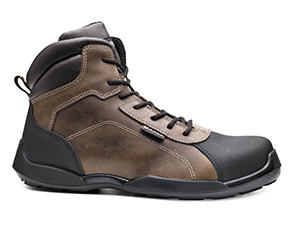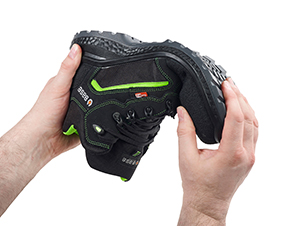Protecting your feet while you work is important, but will a bog-standard pair of safety boots be enough, or is investing a few more pounds worth it to protect your feet in the long-term? Hyde’s John Dabb investigates.
Safety boots are an essential part of PPE which no installer should be without, but all too often we can be led by price rather than comfort when choosing footwear for work. However, choosing footwear that you will spend upwards of 8 to 10 hours a day walking, standing, bending and stretching in should mean that you take time and invest the necessary cash in ensuring your feet will be comfortable all day long. In the long-term, making do with ill-fitting and comfortable footwear can slow you down and even be detrimental to your health.
It isn’t just about spending more money on the appropriate safety footwear either, researching the many different options and trying them on for size is also important. So what are the key things to look out for to ensure your next pair of safety boots are really made for working?
 As a rule, all safety footwear must meet the minimum safety standards set out by the International Organization for Standardization (ISO), with EN ISO 20345:2011 being the current standard for safety footwear across Europe (EN). This stipulates that all safety footwear must have toe protection against a 200-joule impact, meaning the amount of energy the toe region can absorb before breaking. SB safety boots meet this minimum legal requirement.
As a rule, all safety footwear must meet the minimum safety standards set out by the International Organization for Standardization (ISO), with EN ISO 20345:2011 being the current standard for safety footwear across Europe (EN). This stipulates that all safety footwear must have toe protection against a 200-joule impact, meaning the amount of energy the toe region can absorb before breaking. SB safety boots meet this minimum legal requirement.
However, for a little additional cost, S3 boots have a puncture resistant midsole, anti-static properties, resistance to fuel oil on the outsole and energy absorption in the heel region, plus water resistant upper and cleated outsole. With S3 boots, safety combines with comfort in a way that is not guaranteed with standard SB footwear.
 Perhaps the biggest test of comfort and durability for safety boots can be found in the cleat. The majority of SB boots have thick cleated soles made from polyurethane, which is solid and inflexible and therefore don’t give when bending. While most people choose boots because they look robust with thick cleated soles, they are in fact incredibly uncomfortable to wear for long periods of time. Research has proven that they require significantly more force to bend the foot than a flexible soled boot that has the same safety built in. Therefore, a much more effective rule of thumb is to do a flex test: how well does the boot bend at the sole?
Perhaps the biggest test of comfort and durability for safety boots can be found in the cleat. The majority of SB boots have thick cleated soles made from polyurethane, which is solid and inflexible and therefore don’t give when bending. While most people choose boots because they look robust with thick cleated soles, they are in fact incredibly uncomfortable to wear for long periods of time. Research has proven that they require significantly more force to bend the foot than a flexible soled boot that has the same safety built in. Therefore, a much more effective rule of thumb is to do a flex test: how well does the boot bend at the sole?
For just a few pounds more than a standard SB boot and a few minutes spent trying the footwear on before you buy, an S3 safety boot offers a wealth of protection and comfort that you can’t really put a value on when it comes to looking after your feet.

Add new comment